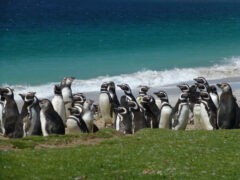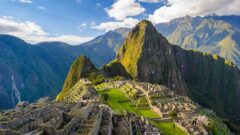Finding my Long-Lost Family in Argentina’s North-West

A few years ago I received a letter from a Hugo Bellos of Tucumán, Argentina. Are we, he asked, related? Yes we are!
Ever since I was a child I have known that my family has an Argentine and a British side, descendents of Ukrainian immigrants called Bialistotski. Moshe Bialistotski went to Rosário, his brother-in-law and cousin Chaim (my great-grandfather) to London. That's where the name Bellos comes from: Moshe thought the Spanish-sounding abbreviation sounded good, so it was adopted first by him and then by the rest of the family.
For the last half century, however, the South American and European Belloses lost touch with each other. Which is why it was so thrilling to hear that they were alive and well. (Hugo had found my address on the internet).
This year I finally travelled to meet them. As well as learning I had dozens of relatives I never knew I had, it was a double treat to realise that they lived in the particularly beautiful and relatively unexplored Andean foothills of the Argentine north-west.
My final destination would be Tucumán, where Hugo owns a business stationers specialising in rubber stamps, but first I flew to Salta, gateway to the region. Salta is a well-scrubbed provincial capital, its centre a pretty grid of colonial buildings. From there I drove north, towards Bolivia, through thick tropical forest and then, as the scenery opened out, into the spectacular Quebrada de Humahuaca, an arid, cactus-lined gorge with sweeping vistas of red and orange stone. A Grand Canyon with llamas.
One of the most remarkable geological formations is the mountain at the village of Purmamarca that glows in seven different colours. The rock has rich mineral sediments from different geological periods that are luminescent as the sun rises in the morning, as if the entire thing is switched on by a magic button.
A decade ago this was backpacker territory. Now, you can visit in style. In Purmamarca I stayed in a delightful boutique hotel, the Manantial del Silencio. The emergence of boutique tourism here is partly to cater for international travellers but also a knock-on effect from the financial crisis of 1999-2002. Argentinians could no longer afford holidays abroad, so they started to look in their own country.
The government has also invested in new roads. Which made the road trip unlike any other I have had in South America, where roads are invariably pot-holed and treacherous. The road that winds up from Purmamarca, altitude 2,200m, to a ridge at 4,100m on the way to a plateau of salt flats, is a destination in itself: more than a dozen beautifully engineered hairpins with heart-stopping views.
I drove back to Salta, en route for Tucumán. Hugo had suggested that his son, Ariel Bellos, my third cousin, meet me halfway, at a town called Cafayate. The road into Cafayate was like driving through a pop-up geographical encyclopedia. I zigzagged round sharp hillocks with tufty green shrubs before it became very mountainous, a dry landscape of red, pink and purple in remarkable shapes: giant amphitheatres inside the rocks and cliff-faces with Gaudiesque turrets.
Cafayate is a booming wine centre, less well-known than Mendoza and San Juan, but with an increasing reputation for its quality. This is, so I was told at one of its many wine-tasting bodegas, because its altitude of 2,000m means the temperature difference is more extreme between day and night, giving grapes thicker skins and the wines more intense flavours.
I waited in my hotel, another neocolonial-style boutique hotel but this time with a view across a vineyard, for Ariel to show. I began to feel a bit nervous. Would we have anything to say to each other? I didn't even know what he looked like, but when he walked into the hotel there was no mistaking: curly hair, light Semitic features, T-shirt and jeans. We stared at each other for a second, and then hugged. "Primo!" said Ariel – 'cousin'.
We headed straight into town. Cafayate is surrounded by mountains and offers healthy activities such as biking trails and walks, and less healthy ones, of course, like sampling the wines. In the town square we sat down at a cafe to drink the area's signature wine, a torrontés, white, light and aromatic – and catch up on 50 years of family history.
The next day Ariel drove us to the Quilmes ruins. Many people will recognise Quilmes as the name of Argentina's national beer; fewer realise that the name originates from the indigenous tribe who lived between Cafayate and Tucumán. The Quilmes were a tenacious people who fought off the Incas and managed to hold off the Spaniards for more than a century until 1667, when the whole tribe was marched 1,600km on foot to a reservation near Buenos Aires, which is now the city of Quilmes – and where the beer was first brewed.
The nearby Museo Pachamama, in Amaicha del Valle, explains the context: an eccentric but brilliant folly that is nominally a museum but really a monument by a local artist to pre-Columbian South America, with bizarre sculptures, mosaics and artefacts.
From Amaicha it is only a few hours' drive through mountains to Tucumán, which is not really on the tourist trail but certainly interesting enough for a day's sightseeing. It is where Argentina declared independence from Spain in 1816.
And Tucumán is of personal importance too, as the home of more than 20 descendants of Morris Bellos, né Moshe Bialistotski. They include (I discovered) a neurologist, a yoga teacher, a puppeteer, a chemistry lecturer and Hugo and his three sons, who run the stationers Todolandia and Copitec, which are situated opposite each other in the city centre.
I always used to consider myself lucky that I had been born into the British branch of my family, but after visiting my "new" relatives I've revised my opinion. None of the Argentine Belloses have ever moved from the north-west, and I can see why. Their quality of life is much better than mine: beautiful scenery, copious amounts of torrontés, and an inexhaustible supply of felt-tip pens.
Tailor-made holidays
Flexible, custom-made holidays to Latin America created to match your exact requirements: our tailor-made itineraries are as unique as the clients for whom they are designed.
Design my tripPapagaio
Your edit for Latin American inspiration
Our exciting range of articles on Latin America explore everything from iconic destinations and lesser-known cultural gems to delicious traditional recipes. You’ll also find exclusive travel tips, first-hand client reviews and the chance to get your personal questions answered by our travel experts.
View Extraordinary Inspiration






































